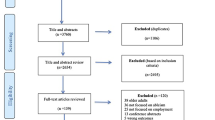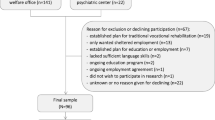Abstract
Background
Work participation is a common activity for young adolescents. Yet it may impact upon other aspects of their lives and their health. We sought to provide some of the first Canadian population-based estimates of 12 to 14 year olds’ employment and work injury experiences, a group typically excluded from labour force statistics.
Methods
Secondary data analysis of school-based surveys in Ontario (ON) in 2003 and British Columbia (BC) in 2005. Questions provided information on participation in formal and informal work during the school year, number of hours worked, and the occurrence of a medically attended work injury for students 12 to 14 years old. Different sampling strategies were accounted for in the analyses, including the calculation of 95% confidence intervals (CI) on prevalence estimates.
Results
Overall, 52.9% (95% CI 48.7–57.1) of ON and 41.5% (39.7–43.3) of BC 12 to 14 year olds reported working during the school year. Mean hours per week ranged from 3.3 (2.5–4.0) among Ontario 12 year olds engaged in non-formal work up to 11.7 (10.0–13.3) among British Columbia 14 year olds engaged in formal work. Work injuries were reported by 6% (4.0–8.9) of ON young workers and 3.5% (2.6–4.8) of BC workers.
Interpretation
Our findings point to the active presence of young adolescents in the labour market. Systematic approaches to active surveillance of work participation and work health and safety for young adolescents across Canada should be developed. Differences in work injury patterns by province may be worthy of further investigation.
Résumé
Contexte
Beaucoup de jeunes adolescents travaillent, mais leur activité sur le marché du travail peut nuire à d’autres aspects de leur vie et à leur santé. Nous avons produit de premières estimations, fondées sur la population canadienne, de l’emploi et des accidents de travail chez les 12 à 14 ans, un groupe généralement exclu des statistiques de la population active.
Méthode
Nous avons analysé les données secondaires d’enquêtes menées dans des écoles de l’Ontario en 2003 et de la Colombie-Britannique (C.-B.) en 2005. Les questions des enquêtes portaient sur la participation à l’emploi structuré et non structuré pendant l’année scolaire, le nombre d’heures travaillées et la survenue d’un accident de travail ayant nécessité des soins médicaux chez les élèves de 12 à 14 ans. Les différentes méthodes d’échantillonnage ont été prises en compte dans nos analyses, notamment par le calcul d’intervalles de confiance (IC) de 95% pour les estimations de la prévalence.
Résultats
Globalement, 52,9% (IC de 95% = 48,7–57,1) des élèves de 12 à 14 ans de l’Ontario et 41,5% (39,7-43,3) des élèves de la C.-B. ont déclaré travailler pendant l’année scolaire. La moyenne hebdomadaire des heures travaillées variait entre 3,3 (2,5–4,0), chez les élèves ontariens de 12 ans ayant un emploi non structuré, et 11,7 (10,0–13,3), chez les élèves britanno-colombiens de 14 ans ayant un emploi structuré. Des accidents de travail ont été déclarés par 6% (4,0-8,9) des jeunes travailleurs de l’Ontario et par 3,5% (2,6–4,8) des jeunes travailleurs de la C.-B.
Interprétation
Ces chiffres confirment que les jeunes adolescents participent activement au marché du travail. Il faudrait donc systématiser la surveillance active de la participation au marché du travail et de la santé et de la sécurité au travail des jeunes adolescents au Canada. On pourrait aussi étudier plus avant les écarts provinciaux dans la structure des accidents de travail.
Similar content being viewed by others
References
Mortimer JT, Finch MD, Dennehy K, Lee C, Beebe T. Work experience in adolescence. J Vocational Educ Res 1994;19(1):39–70.
Lipskie T, Breslin FC. A descriptive analysis of Canadian youth treated in emergency departments for work-related injuries. Chron Dis Can 2005;26(4):107–13.
Parker DL, Carl WR, French LR, Martin FB. Characteristics of adolescent work injuries reported to the Minnesota Department of Labor and Industry. Am J Public Health 1994;84(4):606–11.
Dunn KA, Runyan CW, Cohen LR, Schulman MD. Teens at work: A statewide study of jobs, hazards, and injuries. J Adolesc Health 1998;22(1):19–25.
Human Resources Development Canada. Minimum age for employment in Canada. Ottawa, ON: Labour Program, Human Resource Development Canada, 2004.
Irwin J, McBride S, Strubin T. Child and youth employment standards: The experience of young workers under British Columbia’s new policy regime. Vancouver, BC: Canadian Centre for Policy Alternatives — BC Office, 2005.
Adlaf E, Paglia A. Drug Use Among Ontario Students: Detailed OSDUS findings, 1977–2003 (CAMH Research Document No. 13). Toronto, ON: Centre for Addiction and Mental Health, 2003.
Human Resources Development Canada, Statistics Canada. Growing Up in Canada: National Longitudinal Survey of Children and Youth. Ottawa: Statistics Canada, 1996.
Mortimer JT. Working and Growing Up in America. Cambridge, MA: Harvard University Press, 2003.
Johnson J, Ratner P, Bottorff J, Zumbo B, Shoveller J, Prkachin K. Exploring gender differences in tobacco dependence in adolescents. Funded by the Canadian Institutes of Health Research, 2003.
Breslin F, Smith P, Mustard C, Zhao S. Young people and work injuries: An examination of jurisdictional variation within Canada. Injury Prevention 2006;12:105–10.
International Programme on the Elimination of Child Labour. The end of child labour: Within reach. Geneva, Switzerland: International Labour Organization, 2006. Report No.: ISBN 92-2-116603-1.
Author information
Authors and Affiliations
Corresponding author
Rights and permissions
About this article
Cite this article
Breslin, F.C., Koehoorn, M. & Cole, D.C. Employment Patterns and Work Injury Experience Among Canadian 12 to 14 Year Olds. Can J Public Health 99, 201–205 (2008). https://doi.org/10.1007/BF03405474
Received:
Accepted:
Published:
Issue Date:
DOI: https://doi.org/10.1007/BF03405474




